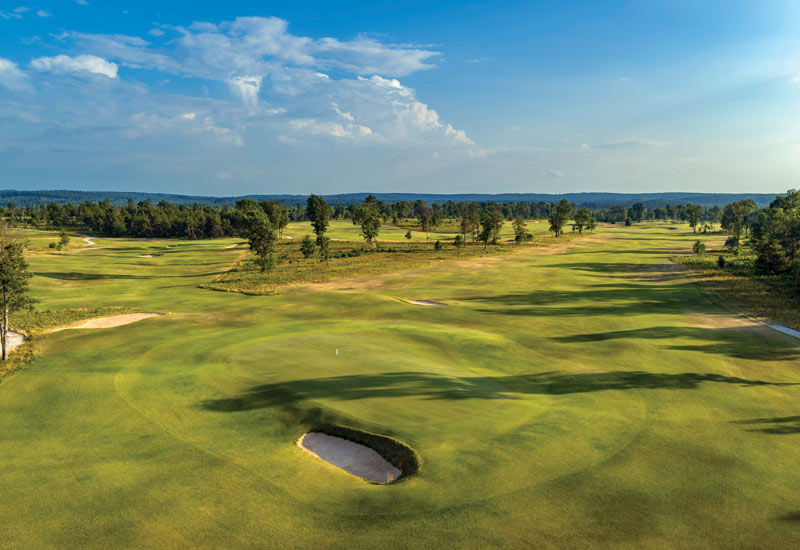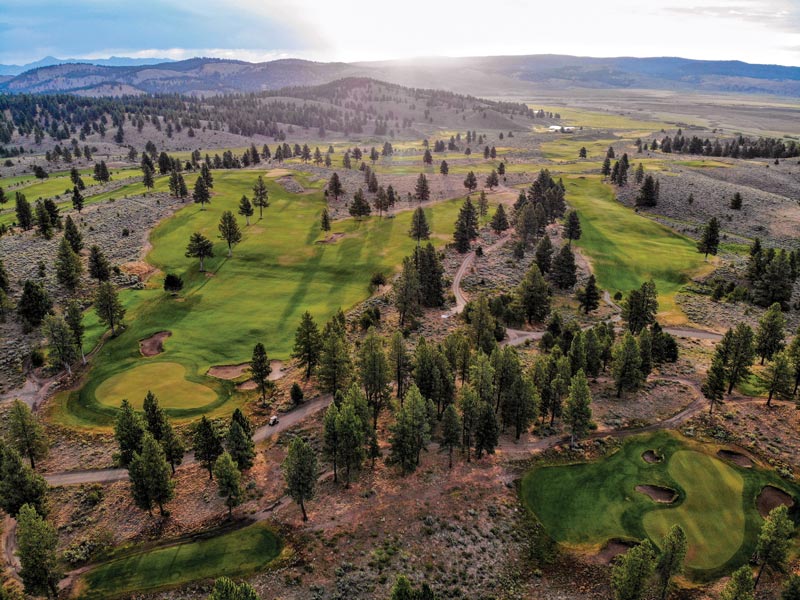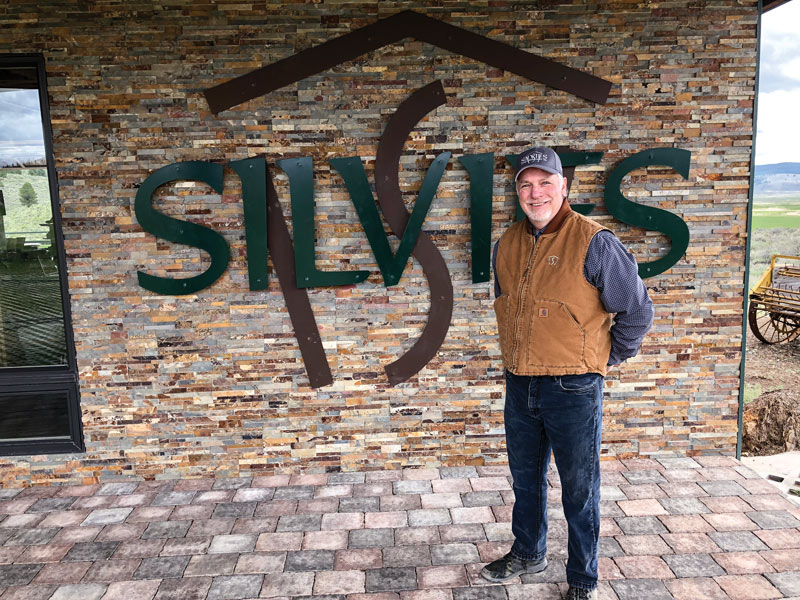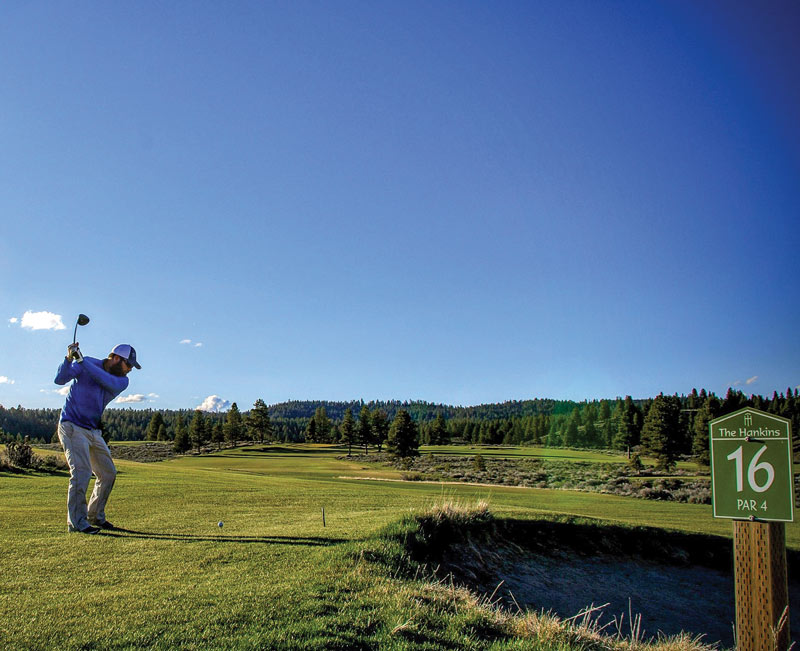
Sunrise on a misty morning at The Loop, the Tom Doak-designed reversible golf course that’s part of Forest Dunes Golf Club in Roscommon, Mich. This view is looking back over the 12th green on the Black Course, which is also the sixth green of the Red Course. Photo by Evan Schiller/courtesy of Forest Dunes Golf Club
The phrase “What goes around comes around” is a timeworn adage often uttered to help soothe the soul of someone who, whether actually or metaphorically, has been wronged by another.
Applied in the not-so-congruent case of golf course architecture, however, the colloquialism can be used to describe reversible layouts, those rare forms of design whose routings are intended to be played different ways on different days.
The concept of reversible courses is a bit foreign to stateside golfers, as well as to the men and women charged with overseeing the nation’s more than 14,000 golf facilities. Those who tee it up and tend to the greens on the other side of the Atlantic may be more familiar with multidirectional layouts, but the idea certainly hasn’t taken the world of golf by storm.
“Honestly, I didn’t even know (reversible courses) were a ‘thing,’” admits Rob Falconer, a nine-year GCSAA member who oversees The Loop at Forest Dunes Golf Club in Roscommon, Mich. “I kind of heard that the Old Course at St. Andrews was meant to be that way, that they had set something up at one time, but no one actually does it now. As far as I knew, that was the extent of what reversible golf was.”
Reversible golf courses: Grounded in tradition
It should come as little surprise that the roots of multidirectional golf can be traced to the birthplace of the game. From the early 1870s until the early 1900s, the Old Course at St. Andrews oscillated between its traditional clockwise routing and the “left-handed” rotation, as it was commonly known.
Records show that every other week, St. Andrews was played from the first tee to the 17th green and continued in a “backwards” fashion until the final hole, which went from the No. 2 tee to the No. 18 green. While golfers enjoyed the variety afforded by the Old Course’s reverse routing, its intended purpose was decidedly more pragmatic: It allowed the turf to heal while “distributing divot patterns across two landing areas, not one,” as described in the British design tome “The Architectural Side of Golf.”
When it made its way to the United States in the early 20th century, reversible architecture was primarily relegated to private golf playgrounds for the rich. William Flynn of Shinnecock Hills fame crafted a sickle-shaped design on the estate of John D. Rockefeller in Mount Pleasant, N.Y. The course, which was built in 1930 and dubbed Pocantico Hills, functions as an 18-hole layout and features nine fairways and 13 greens, five of which are played twice from opposite directions.

The corner where the 12th hole of the Red Course and the sixth hole of the Black Course connect at The Loop at Forest Dunes Golf Club. Photo by Evan Schiller/courtesy of Forest Dunes Golf Club
More recently, architect Steve Smyers built a golf wonderland at Asherwood, the 100-plus-acre estate of the late shopping-mall developer and Indiana Pacers co-owner Melvin Simon. The Carmel, Ind., property boasts 10 fairways and 13 greens that can be played as 27 holes from different teeing areas, as well as a nine-hole, fully reversible par-3 course.
Then there’s Three Ponds Farm, a multidirectional Rees Jones design located in Bridgehampton, N.Y. The 60-acre course, which includes four greens, three fairways and numerous teeing grounds that enable it to be played as 18 holes, anchors a private entertainment enclave that once encompassed a barn, grass tennis court, rose garden, carriage and halfway houses, and a pro shop.
Suffice it to say, only a select few golfers will ever get to see — let alone play — these exclusive links. There are, however, several venues scattered across the U.S. where both the curious and quixotic can experience the game in reverse.
Reversing course to establish a golf destination
Arguably the most famous of reversible courses accessible to the American masses is The Loop, the aforementioned Tom Doak creation that complements a traditional Tom Weiskopf-designed gem at Forest Dunes Golf Club in Roscommon, Mich.
Featuring 18 greens that can be approached from two separate directions, The Loop’s Black routing plays clockwise on odd-numbered days of the month, and it flips to the Red, or counterclockwise, rotation for the even. The links-style course comprises approximately 90 acres of greens, fairways and teeing grounds spread across 300 acres of former forestland, placing it in stark contrast to the parkland-style Forest Dunes course.
Collectively, the Black and Red routings were designed to fill a void at the award-winning facility.

Right: Rob Falconer, the superintendent at The Loop at Forest Dunes Golf Club. Photo courtesy of Rob Falconer
“The problem we had in years past is that Forest Dunes was the pass-through course,” says Falconer, who has overseen maintenance on The Loop since 2017. “Golfers would play us on their way up north to other destinations or on their way back. In order to keep people on property, our owner, Lew Thompson, wanted to add another course.”
Thompson commissioned Doak, who in turn pitched the idea of a reversible course based on the topography of the land and the allure of developing a calling card unlike any other for Forest Dunes.
“It was the perfect scenario, because not only would you be getting a second course to try to get people to stay here, you’d actually get a third course, because it’ll be played in reverse the next day,” says Falconer. “So now you might get them to stay for multiple days. That was the main driver behind The Loop — increasing the number of guests who stay on property at the resort.”
By most measures, the plan is resonating with traveling golfers. All three courses are ranked on Golf Digest’s list of America’s 100 Greatest Public Courses, with Forest Dunes coming in at No. 28 and The Loop landing at Nos. 45 (Black) and 47 (Red). The resort, which showcases a lodge and a number of villas and cottages, also placed among Golf’s Top 100 Resorts in the “Best for Buddies” category in 2019.
Much like Forest Dunes, Silvies Valley Ranch, a Western-themed eco-resort in eastern Oregon, uses “backwards” golf to entice guests to make their rounds the prelude to a mini-vacation. The Retreat & Links at Silvies Valley Ranch is home to four layouts, including the reversible Hankins and Craddock courses, as well as lodge and spa amenities and an array of non-golf offerings.
“This area of what we call ‘frontier Oregon’ is a very different experience for a lot of people because it’s still kind of the ‘cowboy culture’ out here,” explains Sean Hoolehan, CGCS, who oversees all the courses at Silvies Valley Ranch. “Our owner (retired veterinarian Scott Campbell) really wanted that to be part of the experience for our guests.” The uniqueness of a multidirectional course that was created using a wide range of materials from the 140,000-acre ranch only adds to the facility’s folkish aura.

Silvies Valley Ranch in eastern Oregon is home to the reversible Hankins and Craddock courses, which feature more than 100 bunkers and can be stretched to 7,000 yards. Here, the 13th green on the Hankins Course is in the foreground, with No. 14 Hankins in the background. Photo by Torin Foster/courtesy of Silvies Valley Ranch
Set along ridges overlooking Silvies Valley, the Craddock Course stretches to 7,000 yards and is punctuated by dramatic elevation changes and more than 100 bunkers. The Hankins Course, which plays in the opposite direction on alternating days, uses the same land and natural elements.
Rather than forcing the Hankins routing to climb back up steep inclines that would make both play and maintenance more difficult, architect Dan Hixson scattered 27 greens around the property to facilitate play. “You get two courses on the footprint of one or maybe one and a quarter,” says Hoolehan, a 36-year GCSAA member who was the association’s president in 2006, pointing out an intrinsic benefit of poly-rotational routings.
Bobby Jones Golf Course: Filling a niche
On the opposite end of the spectrum, not only in its setting but in construction rationale and design approach, is Bobby Jones Golf Course, a nine-hole facility nestled near the heart of downtown Atlanta. Funded completely by private donations solicited by the Bobby Jones Golf Course Foundation, the Bob Cupp creation replaced an 18-hole layout that had opened in 1932 but fell into disrepair after decades of neglect.
The new Bobby Jones Golf Course debuted in November 2018 and, true to its stated purpose, provides a more fitting tribute to the man whose name is synonymous with golf in Georgia. It also functions as a conduit to deliver affordable golf to the entire community.

The recently reborn Bobby Jones Golf Course near downtown Atlanta features nine large greens that have two hole locations that rotate each day. Photo by Dave Samson/courtesy of Bobby Jones Golf Course
“I know it sounds cliché, but our mission is to grow the game,” says GCSAA Class A superintendent Kyle Macdonald. “We want golfers to come out and have a good time. Bobby Jones is designed to get people back into golf and to enjoy it in an urban environment.”
Featuring seven sets of teeing areas and double greens that accommodate two pin placements, golfers can make their way around each hole twice for 18 holes and a completely different experience. Cupp’s reversible routing also allows the course to be played opposite ways on alternating days, which yields two distinct — and infinitely playable — nine-hole courses known as Magnolia and Azalea. Its configuration also addresses space constraints and flooding issues.
“We only had so much land to work with, so we decided to do nine reroutable holes with a driving range, because we’re in a flood plain,” says Macdonald, a 20-year GCSAA member who was on staff for the majority of the construction of Bobby Jones GC. “By moving the driving range out of the flood plain, we’re able to generate revenue, even when the course is closed. Being a public facility, that’s key.”

Kyle Macdonald, the superintendent at Bobby Jones Golf Course. Photo courtesy of Kyle Macdonald
Today, the Bobby Jones complex includes the reversible course and driving range, a nine-hole putting course, a five-hole par-3 course, and practice facilities for Georgia State University’s men’s and women’s golf teams. It’s also home to the Murray Golf House, which houses the Georgia State Golf Association, the Georgia Section of the PGA and the Georgia Golf Hall of Fame.
Editor’s note: On a pure-sand site in a secluded area of Georgia, superintendent Rhett Baker has helped bring Ohoopee Match Club — an easygoing, whimsical 22-hole layout — to life. Read about it in Ohoopee Match Club: Out of the dunes.
Maintenance challenges of a different kind
Given the rarity of reversible courses, they understandably present some unique challenges for even the most seasoned of superintendents.
Hoolehan, who has worked in the golf industry for more than 40 years, admits he “couldn’t really get my arms around a reversible golf course until I was out here and got to see it and play it.” From a maintenance standpoint, he describes it as “very different.”
Consider communication among staff members. Most superintendents agree that one of the biggest learning curves when training new employees is helping them understand where they are on the property. Those issues are magnified on courses that play in opposite directions depending on the day.
“The first day I was on The Loop and we actually had play, it felt very normal,” says Falconer, who was an assistant at Forest Dunes from 2005 to 2011 before leaving the industry for five years and then returning to oversee The Loop in 2017. “It was the second day when I had to turn the course around — that’s when my mind had to shift.”
To reduce confusion, staff members at Silvies Valley Ranch are taught to always know where they are in relation to the Hankins routing. “My best advice (to workers) is to learn one hole at a time,” Hoolehan says. “Because if you learn where No. 5 is, you’ll always know where Nos. 4 and 6 are.”

Sean Hoolehan, CGCS, at Silvies Valley Ranch. Photo courtesy of Sean Hoolehan
For his part, Falconer makes it a point to remind everyone which rotation The Loop is on (Black or Red) before sending them out on the course each morning.
Communication notwithstanding, Macdonald points to levels of play as one of the primary maintenance hurdles at Bobby Jones. Take, for instance, chemical applications. Instead of it taking a few days to treat the course, it requires upward of a week because work windows are limited.
The same goes for fertilization. Putting the product down is straightforward enough, but Macdonald has to plan schedules around non-play periods to ensure adequate time for post-application watering.
“Once golfers get out there, the golf course is full, and there’s nowhere to hide, from a maintenance standpoint,” says Macdonald, who worked at such private bastions as St. Ives Country Club and Hawks Ridge Golf Club before moving to Bobby Jones. Plus, there are no “maintenance days” when the course is closed for routine or seasonal projects.
Accordingly, Macdonald’s crew is “part-time heavy” each morning to knock out essential duties such as mowing, leaving much of the ancillary and periphery work for full-time employees in the afternoons.
Interestingly, Falconer points to work around the edges as being a particularly vexing component of rotational routing maintenance. “My guys spend a lot of time in what we consider native areas, trying to keep them cleaned up and presentable from both directions,” he says. “Because it’s reversible, you have to look at everything — even areas that might be out of play — from two directions and pay attention to things that you normally wouldn’t see if you just looked at it from one way.”
Benefits by design
Whether natural or not, viewing things from a different perspective often yields positive outcomes that may not otherwise be realized.
In that respect, multidirectional designs offer an array of maintenance advantages that help offset their inherent challenges. Chief among those are reduced chemical inputs, less water use and overall environmental impact, and reduced labor and equipment expenditures.
“The biggest benefit that I’ve seen is logistics,” Macdonald says. “Because we’re landlocked and compact, we can knock out mowing greens very quickly.”
Then, of course, there’s the reason reversible routings were employed at St. Andrews in the first place — less wear and tear on the course.

A golfer tees off on the par-4 16th hole on the Hankins Course at Silvies Valley Ranch. Photo courtesy of Silvies Valley Ranch
“It absolutely helps (with traffic patterns and turf health),” Hoolehan says. “Players are moving from one side to another, then every other day they’re going in different directions and not using the same paths.”
It’s fair to say that reversible courses will never dominate the golf landscape. The numerous challenges, both natural and manmade, would dissuade most designers and course owners from defying convention.
“It really needs the perfect place,” Falconer says. “You’ve got to have the right land to do it and the right ownership. I don’t think you can create a reversible course with the U.S. parkland model — that style of play wouldn’t lend itself very well to a reversible design like the links style does.”
But for those pioneering few who are blessed with a special property, a penchant for nonconformity and a willingness to think outside the proverbial tee box, there’s a chance that courses that come around and go around may one day be placed in more consistent rotation.
“Golf doesn’t change very quickly,” Hoolehan says. “But I think we’re seeing that preconceived notions of what an 18-hole golf course should be are starting to change. I think we’re seeing more acceptance of shorter (and other alternative) courses.”
Ronnie Musselwhite is a South Carolina-based freelance writer and the former editor-in-chief of Golf Business magazine.